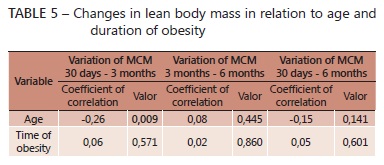BACKGROUND: Calculations of metabolic and physical activity are carried out from the active tissue in the body, known as lean body mass, which is the sum of fat-free lean mass to essential fat. Kinesiotherapy helps in weight strength and flexibility and can be applied in the patients recovery. AIM: In patients undergoing surgical treatment for morbid obesity are the objectives: 1) to evaluate the effect of physiotherapy counter resisted in lean mass; 2) to assess the factors associated with variations in lean body mass with physical therapy; 3) to compare the group of patients who lost lean mass to the one who won using physical therapy, analyzing the co-morbidities that interfered with these results. METHOD: The study included 100 patients operated on by Fobi-Capella technique divided into group A, patients who lost lean body mass measured in two periods (between 30 days and three months between three months and six months) and group B by the patients that gained lean body mass in at least period. Data collection was performed using the Electronic Multiprofessional Protocol of Metabolic and Bariatric Surgery with emphasis in Physical Therapy, identified as SINPE© (Integrated Electronic Protocols). The patients were evaluated pre-operatively and followed in the postoperative period in four phases: in the hospital, 30 days, three months and six months after the operation. RESULTS: There were significant differences between the three assessments (p <0.001). By comparing the 30 days to three months, there was loss of lean body mass with statistical significance (p <0.001). Similarly, between 30 days and six months (p <0.001). However, the period between three months and six months did not show results with significance level (p <0.612), showing a tendency to maintain lean body mass. CONCLUSIONS: Physical therapy counter resisted helped in maintaining lean body mass between the periods of three months and six months; 2) elderly men, diabetic and dyslipidemic lost more lean mass; duration of obesity, cardiovascular and orthopedic disease not changed the lean mass; 3) groups A and B showed no significant differences for both gain and loss lean mass in relation to cardiovascular and orthopedic comorbidities, but patients with diabetes mellitus and dyslipidemia were more prevalent in Group A.
Physical therapy; Obesity; Eletronic protocols






